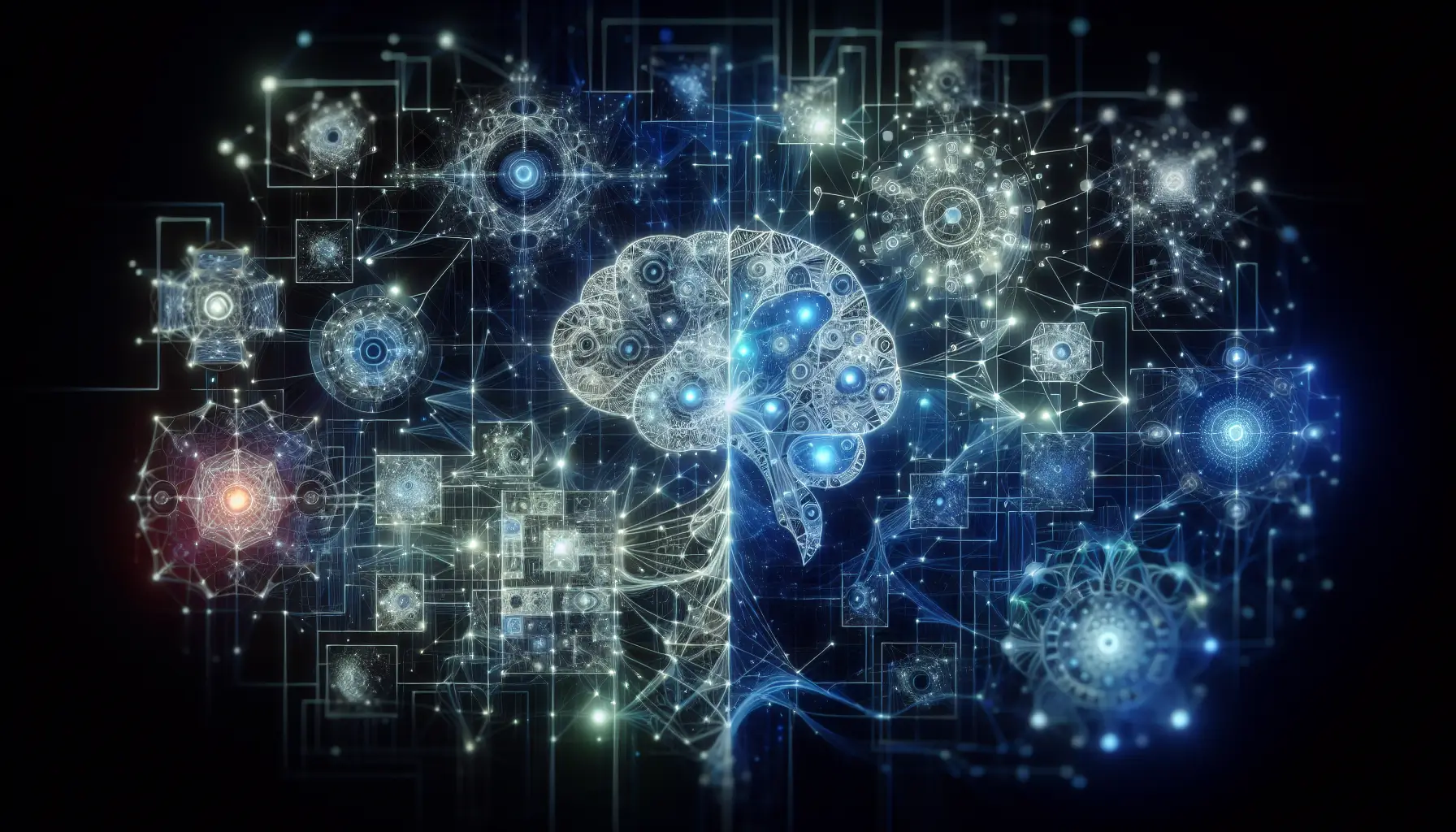Artificial general intelligence (AGI) is the scientific pursuit of creating machines with a breadth of cognitive abilities on par with human intelligence. It stands in stark contrast to current AI, which is designed for specific tasks. In this article, we unravel the enigma of AGI, its progress, the hurdles it faces, and its potential to transform society without spoiling the nuanced debate surrounding its feasibility.
Key Takeaways
- Artificial General Intelligence (AGI) aims to create machines with human-level cognitive abilities across multiple domains, surpassing narrow AI in versatility and offering autonomy similar to human beings.
- Significant challenges to AGI include developing machines with complex sensory perception, motor skills, and the processing power required for simulating neural activity, alongside navigating ethical considerations.
- AGi’s impact on industries like healthcare, transportation, and education could be transformative, but its realization paves the way for societal adjustments and necessitates careful planning and regulatory frameworks.
Based on recent research and discussions in the field of Artificial General Intelligence (AGI), we compiled a featured table that reflects the current trends, challenges, and progressions:
| Category | Key Points | Sources |
|---|---|---|
| Performance | AI surpasses humans in tasks like image classification but struggles with complex problems like competition-level mathematics. | AI Index Report 2024 |
| Capabilities | Advances in multimodal AI allow models to process text, images, and audio, improving flexibility across various domains. | AI Index Report 2024 |
| Benchmarks | New benchmarks have emerged due to AI reaching performance saturation on traditional tests, prompting the development of harder benchmarks. | AI Index Report 2024 |
| Data Utilization | AI-driven data generation enhances capabilities and paves the way for algorithmic improvements. | AI Index Report 2024 |
| Human Interaction | There is a shift towards evaluating AI using human benchmarks, focusing on the quality and reliability of AI-generated outputs. | AI Index Report 2024 |
| Ethical Concerns | Issues of bias, job displacement, and the ethical use of AI are major concerns as systems approach AGI capabilities. | OpenAI, Planning for AGI, and Beyond |
| Research Direction | Significant emphasis on creating more aligned and controllable AI models to ensure safe and ethical advancements. | OpenAI, Planning for AGI, and Beyond |
| General Intelligence | While current AI exhibits some features of general intelligence, true AGI remains elusive, often limited to specific domains. | How Can the Current State of AI Guide Future Conversations of General Intelligence? |
This table encapsulates the multifaceted nature of AGI research, highlighting both the technological advancements and the societal implications. The sources, such as the AI Index Report 2024 and OpenAI’s insights, provide a comprehensive overview of where the field stands today and the directions it may take. This dynamic field continues to evolve, driven by both technological breakthroughs and ongoing debates about the best paths forward for integrating AI into society responsibly.
The Essence of Artificial General Intelligence (AGI)

Artificial General Intelligence (AGI) encapsulates the pinnacle of machine intelligence, with the goal of mirroring the broad spectrum of human intelligence. It is a bold endeavor, not just to replicate human capabilities in a specific domain but to develop AGI systems capable of performing a wide array of intellectual tasks, including:
- complex problem-solving
- generating human language
- learning and adapting
- understanding and interpreting sensory information
- reasoning and decision-making
Computer scientists’ pursuit of generalized human cognitive abilities is not merely about augmenting human intelligence; it is about creating a machine with true human-level intelligence and self-awareness, mimicking the complexity of the human brain.
The quest for AGI is one of the most ambitious goals within computer science and AI research, driven by the desire to see machines not only solve tasks but to have complete knowledge and understanding of the world around them. This potential leap from narrow AI, which excels at specific tasks guided by human intervention, to AGI, which operates across multiple domains autonomously, marks a pivotal shift in artificial intelligence AI.
Delving into the core of AGI reveals a vision with the potential to revolutionize our perception of human-like intelligence and machine capabilities.
Defining AGI: Beyond Narrow AI
Artificial General Intelligence (AGI) surpasses the confines of narrow AI, aiming to resolve a wide spectrum of problems to reflect the adaptability and expanse of human cognition. While narrow AI focuses on specialized tasks within a controlled environment, AGI systems are designed with a level of general intelligence that enables them to handle challenges in computer vision, natural language understanding, and even adapting to unforeseen circumstances, rivaling human capabilities. AI researchers are leveraging a variety of approaches, including hybrid, symbolic, and connectionist methods, to equip AGI systems with a scope of cognitive abilities that are not constrained by the domains they were originally designed for.
While the progress in artificial intelligence has yielded generative AI models and advanced technologies, realizing strong AI that can match generalized human cognition continues to pose a challenge for researchers. AGI aims to represent a paradigm shift wherein machines will not only augment human intelligence but also operate with a level of autonomy and flexibility that has so far been the domain of science fiction. This distinction sets artificial general intelligence AGI apart from the current AI systems and guides us toward a future where machines might walk alongside us as intellectual equals.
AGI vs. Weak AI: A Comparison
The artificial intelligence landscape is populated with AI systems, known as weak or narrow AI, which excel in their specialized fields. These systems are highly efficient at specific tasks, such as image recognition or language processing, but their expertise does not translate to other domains. Weak AI excels in its programming but lacks the adaptability and common sense required to navigate new situations or understand the world in a holistic manner. Contrast this with the aspirational goals of AGI systems, which aim not just to perform a task efficiently but to understand and learn any intellectual task that a human can, thereby achieving strong AI.
AGI systems are projected to have the ability to autonomously identify problems, devise solutions without direct human programming, and possess decision-making skills comparable to human reasoning. This represents a significant leap from the narrow focus of current AI technologies, where even the most advanced systems still require human oversight and specific instructions to operate. AGI remains an aspirational goal for AI researchers, characterized by the ability to learn and perform any task that a human can do. As we examine the differences between AGI and weak AI, we not only appreciate the progress made but also the magnitude of the journey ahead.
The Vision of AGI: Science Fiction to Science Fact

The transition of artificial intelligence from science fiction narratives to real-world research labs has been a significant journey. Artificial General Intelligence AGI encapsulates this journey, representing the ultimate goal of AI research – to create a machine with the capability to understand and learn any intellectual task that a human being can. It’s a vision that has captivated the imaginations of computer scientists and the public alike, transforming the once fantastical idea of full artificial intelligence into a pursuit grounded in ongoing research and innovation.
The landmark achievement of AlphaGo by DeepMind in 2016 stands as a testament to the progress towards this goal, marking a significant milestone in the development of AI technologies with human-like intelligence. This breakthrough in machine intelligence, which showcased a computer program mastering the ancient game of Go, exemplifies the strides being taken toward generative AI that can rival human capabilities. As we reflect on the evolution of AGi from science fiction to a tangible scientific pursuit, it’s clear that the boundaries of what artificial intelligence can achieve are expanding, paving the way for a future where general artificial intelligence may become a reality.
The Inner Workings of AGI Systems

AGI systems epitomize the peak of AI research, with the ongoing pursuit to create machines resembling human intelligence continually expanding the realm of possibilities. At the core of these complex systems lies deep learning, a subset of machine learning that utilizes artificial neural networks to discern intricate patterns within data. Representation learning is another critical component, focusing on identifying more straightforward representations within high-dimensional data, a process essential for facilitating learning in AGI by simplifying the learning process. These technologies, along with cognitive architectures, form the bedrock upon which AGI aims to construct human-level performance in decision-making and problem-solving.
However, emulating human intelligence is not a mere matter of developing sophisticated computer programs; it involves replicating complex cognitive processes such as reasoning, common sense, and an understanding of human behavior. Current ai systems are still grappling with these challenges, highlighting the gap between the capabilities of today’s AI and the ambitious vision of general artificial intelligence.
Robotics integrated with AGI enriches systems with sensory perception and physical manipulation capabilities, which are crucial for interaction with the physical world and bridging the gap to achieve true human-level intelligence.
Cognitive Architectures: Mimicking the Human Mind
Deep within the realm of AGI lies the concept of cognitive architectures, intricate frameworks designed to mimic the multifaceted nature of the human mind. These architectures are not just about processing data; they are about integrating various types of knowledge representation—texts, images, audio, video, databases, graphs, and neural networks—into a unified base that mirrors the breadth of human cognition.
To achieve human-level performance, AGI systems must have functional blocks that can handle a diverse range of cognitive tasks, including:
- Understanding human language
- Performing complex systems analysis
- Recognizing and interpreting visual information
- Processing and understanding audio
- Analyzing and extracting information from databases
- Reasoning and problem-solving
By incorporating these capabilities into their cognitive architectures, AGI systems can approach the level of cognitive complexity seen in the human mind.
Researchers are exploring multiple avenues, such as the universalist approach, focusing on computational complexities, and the whole organism architecture approach, which aims to promote learning through physical interactions by integrating AI models with a physical representation of the human body. These efforts underscore the commitment to achieving AGI that can perform intellectual tasks with the same dexterity and understanding as a human being, transcending the capabilities of current ai systems.
Learning and Adaptation in AGI
The capacity to learn and adapt, a distinctive trait of human intelligence, is what AGI systems aim to emulate. However, one of the significant impediments to realizing AGI is the current lack of effective protocols for collaboration among AI and machine learning systems. For AGI to reach its full potential, it must not only accumulate knowledge but also apply it across different contexts, learning from each interaction and adapting to new situations with minimal human intervention.
This level of autonomy and adaptability in learning is what separates AGI from the generative AI models and artificial neural networks of today. While these systems have demonstrated impressive capabilities within their respective domains, they fall short of the generalized human cognitive abilities that AGI aims to achieve. The journey towards an AI system that can seamlessly augment human intelligence requires not only advancements in machine learning and deep learning but also a revolutionary approach to how these systems communicate, learn, and evolve together.
Decision-Making: The AGI Approach
The decision-making capability of AGI systems is a vital facet of their development, embodying their ability to scrutinize extensive datasets and solve problems in a manner similar to humans. While current AI systems have achieved human-level performance on several benchmarks, AGI seeks to revolutionize scientific research and other fields by suggesting new directions for exploration and discovery based on its analysis of extensive data sets. However, problem-solving in AI systems currently struggles with a lack of common sense and the inability to simulate everyday scenarios effectively.
To overcome these challenges, AGI must develop sophisticated sensory perceptions that allow it to interpret and engage with the world in a manner akin to human comprehension. This development challenge is significant, as it involves creating a level of understanding in machines that goes beyond the processing of data and into the realm of human-like intelligence. The future of AGI systems, therefore, rests not just on their computational abilities but also on their capacity to make complex decisions by understanding human-like sensory perceptions, a step towards achieving strong AI that truly mirrors the intellectual task performance of a human being.
AGI’s Potential Applications and Impact
Artificial General Intelligence (AGI) holds extensive and diverse potential applications and impacts, spanning across multiple industries with the potential to significantly boost the global economy. In healthcare, AGI could revolutionize diagnostics and patient care by analyzing patients’ genetic data and medical history to create targeted treatments, offering a level of personalized medicine that could dramatically increase the quality and effectiveness of healthcare. Similarly, the finance sector stands to benefit from AGI’s development and operation of complex trading algorithms that analyze massive datasets to improve investment strategies and enhance fraud detection.
Beyond these industries, AGI’s potential extends to:
- Individualizing learning in education
- Optimizing manufacturing processes
- Creating highly tailored entertainment experiences
- Fostering environmental sustainability
- Improving safety in transportation, particularly with the advancement of autonomous vehicles
The transformative impact of AGI systems is not limited to enhancing existing processes but also includes refining customer service by understanding and responding to human language and needs.
As we explore the potential applications of AGI, it becomes apparent that the technology could significantly alter the way we live, work, and interact with the world around us.
Revolutionizing Healthcare with AGI
AGI’s transformative potential in healthcare is set to herald a new age of medical innovation and enhanced patient care. AGI could provide significant improvements in healthcare, including:
- Cancer research: leveraging logistics and precision-centered objectives that could lead to the next generation of diagnostics and treatments.
- Analysis of complex biological data: AGI systems have the ability to analyze complex biological data and recognize patterns that may escape human experts.
- Accelerated discovery of breakthrough therapies: AGI systems could accelerate the discovery of breakthrough therapies, leading to faster advancements in medical treatments.
- Personalization of healthcare services: AGI systems could enhance the personalization of healthcare services, tailoring treatments and care plans to individual patients.
These advancements have the potential to revolutionize healthcare and improve patient outcomes.
This revolution in healthcare is not just about advancements in research; it also encompasses the potential to improve the entire ecosystem of patient care. From streamlining administrative processes to enabling remote monitoring and personalized medicine, AGI stands to augment human intelligence in ways that could greatly improve the efficiency and efficacy of healthcare delivery. As AGI continues to evolve, its impact on healthcare could be one of the most profound, promising a future where technology and medicine converge to improve human life.
AGI in Autonomous Vehicles
The field of transportation stands on the verge of a revolution, steered by AGI in the development of autonomous vehicle technology. AGI can navigate self-driving cars through unfamiliar roads by processing real-time data to make informed navigational decisions, enhancing the safety and efficiency of travel. Beyond mere navigation, AGI can offer personalized recommendations to passengers, using its understanding of a vast array of complex variables, from traffic patterns to individual preferences.
This level of sophistication in autonomous vehicles is not just about getting from point A to point B; it’s about transforming the entire travel experience. AGI can adapt its conversation dynamically with passengers, leveraging insights from their interests and past interactions, suggesting routes, destinations, and even entertainment based on contextual understanding. As AGI technology continues to mature, the impact on autonomous vehicles and the broader transportation sector will be profound, signaling a shift towards a more connected, intelligent, and user-centric mobility landscape.
Enhancing Education through Personalized Learning
With the integration of Artificial General Intelligence, education is on the threshold of a transformation. AGI has the potential to revolutionize the way learning is delivered by tailoring experiences to individual student needs through Intelligent Tutoring Systems. These systems, powered by AGI, can offer immediate, specific, and actionable feedback, promoting an efficient and personalized learning journey for each student.
The incorporation of AGI into Intelligent Tutoring Systems not only enhances their effectiveness but also brings a new dimension to educational technology. With real-time analysis of student performance, these systems can adapt learning experiences, ensuring that each learner receives the support and challenges needed to thrive. Furthermore, AGI’s advanced natural language processing capabilities facilitate better communication and understanding between the system and students, making learning more engaging and accessible.
With AGI’s help, the education sector can:
- Go beyond personalized learning to include intelligent assessment systems
- Create interactive educational games
- Foster an environment where students are inspired to explore and grow.
The Roadblocks to Achieving True AGI
Despite AGI’s promising potential, the journey towards achieving genuine human-level AI is laden with significant obstacles and challenges. AGI requires the mastery of advanced skills that encompass:
- sensory perception
- complex motor skills
- natural language understanding
- problem-solving
- human-level creativity
- the ability to form social and emotional connections
This diverse skill set mirrors the breadth of human capabilities. Furthermore, the computational power required for AGI presents a significant hurdle; simulating just one second of neural activity can take a supercomputer like Fujitsu’s K over 40 minutes, highlighting the immense processing demands of developing AGI.
These challenges are not merely technical but also conceptual, as AGI aims to replicate the full spectrum of human abilities, from the most mundane to the most complex tasks. Achieving this level of cognitive abilities in a machine is an intellectual task that pushes the frontiers of computer science, data science, and cognitive psychology. The pursuit of AGI is an interdisciplinary endeavor that calls for a deep understanding of the human mind and the intricacies of human intelligence. As researchers continue to explore the possibilities of AGI, the roadblocks serve as reminders of the monumental effort required to bring such a transformative technology into existence.
Overcoming Limitations of Previous AI Models
The journey toward AGI involves overcoming the inherent limitations of previous AI models, which often fail to make connections between domains as humans naturally do. Current AI models, including large language models and deep learning systems, are reaching a point of stagnation, where the cost of training larger deep learning models yields only incremental advancements.
This has led to a realization within the AI community that novel approaches are needed to bridge the gap between narrow AI and the comprehensive capabilities envisioned for AGI. Some potential approaches include:
- Integrating symbolic reasoning with deep learning techniques
- Developing hybrid models that combine different AI architectures
- Exploring new paradigms such as neuro-symbolic AI
By exploring these new approaches, researchers hope to unlock the full potential of AGI and create AI systems that can truly understand and interact with the world in a human-like manner.
One significant shortcoming of previous AI models is the absence of established protocols for AI collaboration, which is vital for the implementation of fully operational AGI systems. While hyper-automation adds a sophisticated layer to existing automation technologies, it does not equate to the broad, adaptive, and generative capabilities proposed for AGI. Overcoming these limitations requires a new paradigm in artificial intelligence research, one that encourages machines to learn from each other and solve problems across a spectrum of domains without human intervention. The development of AGI depends on the ability of AI systems to not only process and represent knowledge but also do so in a way that reflects the interconnectedness of human comprehension.
Ethical Considerations in AGI Development
With AGI’s ongoing development, addressing the ethical considerations associated with such a potent technology becomes of utmost importance. The potential risks of AGI, including misuse, drastic accidents, and societal disruption, have sparked controversy and debate among AI researchers and ethicists alike. New cognitive architectures for AGI that incorporate machine consciousness and ethics are crucial for navigating these ethical considerations responsibly. Addressing potential societal impacts, ensuring responsible development, and tackling issues of bias and data privacy are among the critical ethical considerations in AGI research.
Collaboration and international cooperation are key to overcoming the challenges inherent in AGI research, fostering shared knowledge advancement, and establishing legal frameworks to ensure ethical development. The speculative timeline for AGI development and its eventual uncertain societal impact underscore the need for prudent governance and ethical frameworks that align AGI with human values. As we advance toward the creation of AGI, it is essential to consider not only the technological implications but also the moral and societal ramifications to ensure that the development and integration of AGI into society benefits all.
Bridging the Gap: Sensory Perception and Fine Motor Skills

One of the primary challenges in AGI development is closing the divide in sensory perception and fine motor skills, which are crucial for equipping machines to interact with the world like humans. Historical AI models, including advanced deep learning systems, have struggled with issues of sensory perception, such as poor color perception and confusion due to minor alterations in visual inputs. Furthermore, programming robotic hands to manipulate objects, a seemingly effortless task for humans, has highlighted the current limitations in AGI’s motor skills.
Developing these skills is not simply a matter of improving technology; it involves creating a deeper understanding of how humans use sensory information and fine motor skills to navigate and interact with their environment. For AGI to truly mirror human capabilities, it must be able to perform specific tasks that require background knowledge, contextual understanding, and adaptive learning.
The ability to perceive the world with the depth and nuance of human senses and to execute complex tasks with the precision of human hands represents a profound step forward in achieving AGI. This development will not only enable more nuanced interactions with the environment but also pave the way for AGI systems to participate more fully in human life.
AGI Research and Innovation: Where Are We Now?
The existing landscape of AGI research and innovation is characterized by notable advancements and the unwavering pursuit of the ambitious goal of creating AI systems that closely emulate human performance. The journey towards AGI is not a solitary one; it encompasses a myriad of considerations across technical, ethical, and safety domains to ensure responsible progress in the field. Developments in artificial intelligence have already enabled the creation of more sophisticated cognitive algorithms that are critical for AGI development, indicating that the path forward, while challenging, is being actively paved by researchers and innovators worldwide.
The ambition to develop AGI systems that can perform general problem-solving skills across various domains has led to a vibrant ecosystem of AI research entities. Tech majors like Google and Meta, alongside emerging AI labs, are at the forefront of these pioneering endeavors, all aiming to advance machine intelligence. The progress made thus far suggests that the possibility of reaching AGI may be closer than previously thought, with initiatives spearheaded by entities like OpenAI showcasing promising advancements. However, as we stand on the precipice of potentially realizing AGI, it is essential to remain cognizant of the current AI systems’ capabilities and the distance still to be traveled.
Pioneering AGI Projects and Their Progress
Pioneering AGI projects are the beacons of progress, illuminating the path towards achieving AGI. OpenAI’s GPT-4, and its subsequent iteration GPT-4 Turbo, are prime examples of such advancements, showcasing an unprecedented level of natural language understanding and problem-solving abilities. These models represent a significant stride towards bridging the gap between human common sense and AI capabilities, reaffirming the potential of AGI to augment human intelligence in ways previously imagined only in science fiction.
The landscape of AGI projects is diverse, encompassing not just advancements in generative AI models but also the exploration of new AI technologies and methodologies. The ongoing debate about whether modern large language models like GPT-4 are early forms of AGI or still incomplete in replicating human intelligence reflects the complexity and nuance involved in AGI development.
As these pioneering projects continue to evolve, they offer a glimpse into the future trajectory of AGI, suggesting that the dawn of machines with human-like intelligence may be on the horizon.
Collaborative Efforts in AGI Research
Collaborative efforts in AGI research are not only beneficial but essential for overcoming the myriad of challenges that lie ahead. OpenCog, an open-source project, exemplifies this collaborative spirit by inviting contributions from individuals passionate about the complex field of AGI. The discussion surrounding AGI often transcends technical aspects, delving into philosophical realms such as decision theory, logic, and mathematics, with resources like Yudkowsky’s website and Arbital providing platforms for such discourse.
Research in psychology, particularly in consciousness and cognition, plays a crucial role in AGI studies. Significant papers addressing theories like the global workspace theory and the free-energy principle contribute to the understanding and development of AGI. Additionally, category theory is being explored for its potential applications in AGI, offering a unified framework for various mathematical concepts that could prove pivotal in advancing AGI and other AI-related fields.
While conventional machine learning techniques like neural networks and reinforcement learning are powerful tools for narrow AI, their ability to achieve AGI is under debate. However, ongoing research may alter this perspective as collaborative efforts continue to push the boundaries of what’s possible in artificial intelligence.
The Future Trajectory of AGI Development
The future trajectory of AGI development is a topic of intense speculation and varied predictions. Opinions on when AGI might be realized range from a few years to over a century, with some researchers even considering the possibility that it may never be achieved. The emergence of AGI promises to establish new market leaders and reshape the competitive landscape, much like the rise of FAANG companies during the internet revolution.
This diversity of forecasts reflects the inherent uncertainties and complexities involved in developing AGI. While some see a swift approach to a world enhanced by AGI, others anticipate a more gradual progression, allowing society time to adapt strategically and implement necessary regulations. As research continues to advance, it is clear that AGI holds the potential to be a catalyst for innovation and change, presenting opportunities and challenges that will require careful consideration and collaboration across multiple disciplines.
Preparing for an AGI-Enhanced World

As we inch towards the realization of AGI, the need for society to brace for its incorporation into our everyday lives escalates. Businesses, in particular, often struggle with comprehending the full scope of AGI systems and lack a defined AI-based plan and strategic direction, which is crucial for achieving business goals. Business executives are encouraged to set clear objectives, identify key performance indicators (KPIs), and track the return on investment (ROI) of AI implementation to effectively prepare for AGI. Building robust data infrastructure and fostering collaborative environments for seamless human-AI interaction are also vital steps organizations can take to ready themselves for the arrival of AGI.
Platforms like IBM Watson serve as recommended resources for businesses to develop an AI strategy in preparation for AGI, ensuring they are technologically equipped to harness its capabilities. Organizations are already adopting AI/ML models to gather and analyze data, derive insights, and improve the effectiveness of operations in areas such as sales, marketing, and customer service. A gradual transition to AGI is advocated to allow society to adapt strategically, providing time to understand AGI’s implications, experience its benefits and downsides, and implement necessary regulations.
As AI usage increases, foundational questions arise regarding:
- the actions allowed by AI systems
- combating bias
- handling job displacement
- addressing further ethical concerns
The aspirational goal for AGI is to contribute positively and be aligned with the flourishing of humanity, ensuring that its development and integration into society benefit all.
Augmenting Human Workforce with AGI
The emergence of AGI promises to enhance the human workforce in ways never seen before. Across various careers, AGI could serve as a collaborative partner, enhancing decision-making and task execution with its advanced cognitive abilities. By performing innovative, imaginative, and creative tasks, AGI enables machines to support and even inspire human workers, leading to more efficient and intelligent workflows.
The integration of AGI into workplaces is not about replacing the human workforce but about complementing and enhancing human intelligence. AGI systems can analyze complex data, provide insights, and assist in decision-making processes, allowing human workers to focus on higher-level tasks that require emotional intelligence and creativity. As AGI becomes more prevalent in the workforce, it will be crucial to navigate the balance between human and machine collaboration, ensuring that AGI serves as an empowering tool rather than a disruptive force.
AGI and the Transformation of Industries
AGI’s transformative influence goes beyond individual workplaces, impacting entire industries. AGI has the potential to actively manage complex networks, such as supply chains and energy grids, by adapting in real-time to changes and optimizing operations. This capability could lead to significant improvements in efficiency, resilience, and sustainability across various sectors, from manufacturing to logistics.
As industries embrace AGI, they will experience a shift towards more intelligent and interconnected systems. AGI’s ability to analyze and respond to a multitude of variables in real-time will enable businesses to be more responsive to market demands, environmental changes, and unforeseen challenges. This shift will not only transform how industries operate but also how they innovate, driving the development of new products and services that leverage AGI’s advanced capabilities.
Addressing the Risks: Human Oversight and Control
The enhanced capabilities of AGI necessitate increased vigilance and control. Maintaining human oversight over AGI systems is critical to prevent incorrect decisions and protect against exploitation by malicious entities. As AGI technology develops, an increasing number of professionals specializing in AI security will be required to ensure that these systems operate within safe and ethical boundaries.
Implementing safeguards in AGI systems is essential for their ethical and safe utilization. These safeguards should be designed to ensure that AGI’s actions align with human values and societal norms, mitigating the risks associated with such potent technology. Given AGI’s potential to significantly alter the world, human oversight will play a crucial role in guiding its development and integration into society, ensuring that its benefits are maximized while its risks are minimized.
Summary
In conclusion, Artificial General Intelligence (AGI) represents a transformative leap in the realm of AI, with the potential to significantly enhance human capabilities and revolutionize industries. The journey towards AGI is marked by substantial challenges, from technical and computational hurdles to ethical considerations and the need for human oversight. As we continue to advance in this exciting field, it is crucial to foster collaborative research efforts, prepare strategically for the integration of AGI, and ensure that its development is aligned with the betterment of humanity. The future of AGI is a canvas of endless possibilities, and the choices we make today will shape the impact of this remarkable technology on our world.
Frequently Asked Questions
What distinguishes Artificial General Intelligence (AGI) from narrow AI?
AGI is distinguished from narrow AI by its ability to perform a wide range of intellectual tasks across multiple domains, similar to human cognitive capabilities, while narrow AI focuses on specialized tasks within a controlled environment and lacks AGI’s adaptability.
How does AGI aim to replicate human decision-making abilities?
AGI aims to replicate human decision-making abilities by analyzing vast datasets, understanding human-like sensory perceptions, and simulating human thought processes and reasoning in problem-solving.
What are some potential applications of AGI in our daily lives?
AGI could potentially revolutionize healthcare, enhance safety in autonomous vehicles, and personalize learning experiences in education through adaptive learning systems. This could lead to significant improvements in daily life.
What are the main challenges in developing AGI?
Developing AGI presents challenges in mastering sensory perception and complex motor skills, addressing ethical considerations, and overcoming the limitations of current AI models. It also requires substantial computational power.
How can society prepare for the integration of AGI?
Society can prepare for the integration of AGI by establishing clear usage objectives, developing strong data infrastructure, promoting collaboration between humans and AI, and implementing oversight to manage ethical risks. This will help ensure a smooth and responsible integration of AGI.







